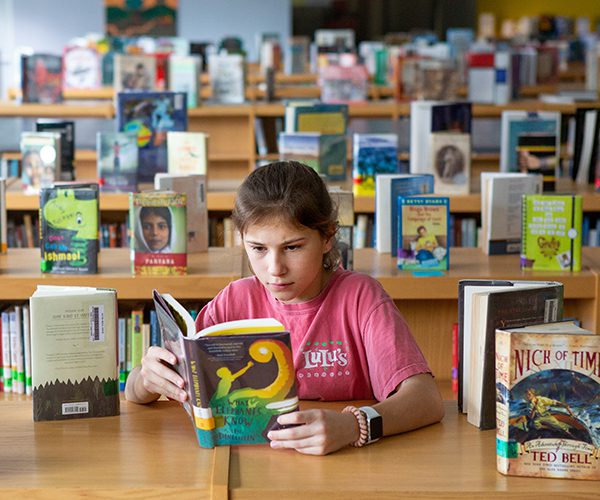Hiding In Plain Sight: How Complex Decoding Challenges Can Block Comprehension for Older Readers
Complex decoding challenges are hiding in plain sight and can prevent older readers from comprehending grade-level texts.

The news about American students’ reading abilities isn’t good: For far too long, our education system has failed to teach many children to become proficient readers. Recently, there has been a lot of focus on learning losses experienced by students of all ages during the pandemic — including, unfortunately, in reading. Less than one-third of all students scored at Proficient or above on the 2022 National Assessment of Educational Progress (NAEP) reading assessment. But our struggles to effectively teach all students to read didn’t start in March 2020; they were evident long before then. For example, decades of assessment data shows that, fewer eighth graders demonstrate grade-level reading proficiency on tests like the NAEP than do fourth graders, even though eighth graders have had four more years of schooling than fourth graders have.
A lot happens between fourth grade and eighth grade, but one thing students rarely receive during those years is explicit instruction in foundational literacy skills. Why does explicit instruction in reading stop after third grade? Conventional wisdom holds that, once students have mastered basics like phonics, which focuses on decoding one- and two-syllable words, they know “how” to read and need little or no further support to be able to decode more complex words. After third grade, instruction generally shifts to support students’ higher-order reading skills, like fluency and comprehension.
People often blame smartphones and other digital distractions as the reason why so many kids today aren’t good readers. But the low reading proficiency rates of middle school students predate the advent of the smartphone, so the answer must lie elsewhere. An often-overlooked culprit may be the increasing demands placed on older students’ foundational literacy skills once they must independently read and comprehend complicated, discipline-specific texts: Students in upper elementary and middle school often encounter texts that feature sentences with more complicated syntax than those used in early elementary texts or in their everyday speech. These more complicated texts are loaded with words derived from other languages, like Latin and Greek, which have different spelling conventions than the words students learned in their basic phonics lessons. Older students must also draw on their implicit knowledge of morphology (e.g., recognizing the relationship between words like “merry” and “merriment”). A student whose foundational literacy skills allowed her to read third grade texts proficiently might struggle in sixth or seventh grade to decode abstract, multisyllabic words like “tenacious,” “inclination,” or “xeriscape.”
The widespread belief that the basic decoding skills students have acquired by the end of third grade will provide a sufficient foundation for their future reading growth may actually be undermining our efforts to move the needle on older students’ literacy. Complex decoding challenges are hiding in plain sight and can block older readers from comprehending grade-level texts.
In 2019, a team of researchers at the Educational Testing Service (ETS) published groundbreaking research that drew on an unusual dataset measuring the foundational literacy skills of students in upper elementary, middle, and high school. Assessments designed to test older students’ reading abilities almost always measure comprehension alone; they do not provide any information about students’ foundational skills, like decoding. By using this unique dataset, the ETS team was able to examine the relationship between older students’ decoding skills and their reading comprehension, and the team discovered a decoding threshold: Older students with low decoding skills had consistently low reading comprehension scores, while the students whose decoding scores were above a threshold value had much better comprehension scores. This phenomenon reveals that, while decoding skills alone are no silver bullet to address all older students’ literacy learning needs, the students whose decoding skills are not yet strong enough to read complex text accurately and efficiently will struggle to comprehend that complex text.
The relationship between decoding ability and comprehension at any age might seem obvious, but it has largely been missing from conversations about supporting older students’ literacy development. It’s hard to talk about something we cannot see or describe; without accurate diagnostic information about older students’ foundational skills, their teachers quite literally cannot know how to support them. The good news is that there is a path forward: Schools can now easily adopt validated screening assessments — e.g., tests like ROAR or Capti Assess — to measure foundational literacy skills among older students. Widespread use of a screening test will enable educators to identify the students who need continued instructional support in foundational literacy skills. Meanwhile, Reading Reimagined, a program by the Advanced Education Research and Development Fund (AERDF), is partnering with researchers to develop both assessment and instructional solutions that will allow teachers to support their older students to cross the decoding threshold, so they can focus on comprehending what they read. Having actionable data is, of course, just the first step to ending the literacy crisis, but every successful journey begins with a first step.
Rebecca Kockler is the Executive Director and Rebecca Sutherland is the Associate Director of Research of Reading Reimagined. Reading Reimagined is a program by the Advanced Education Research & Development Fund (AERDF).